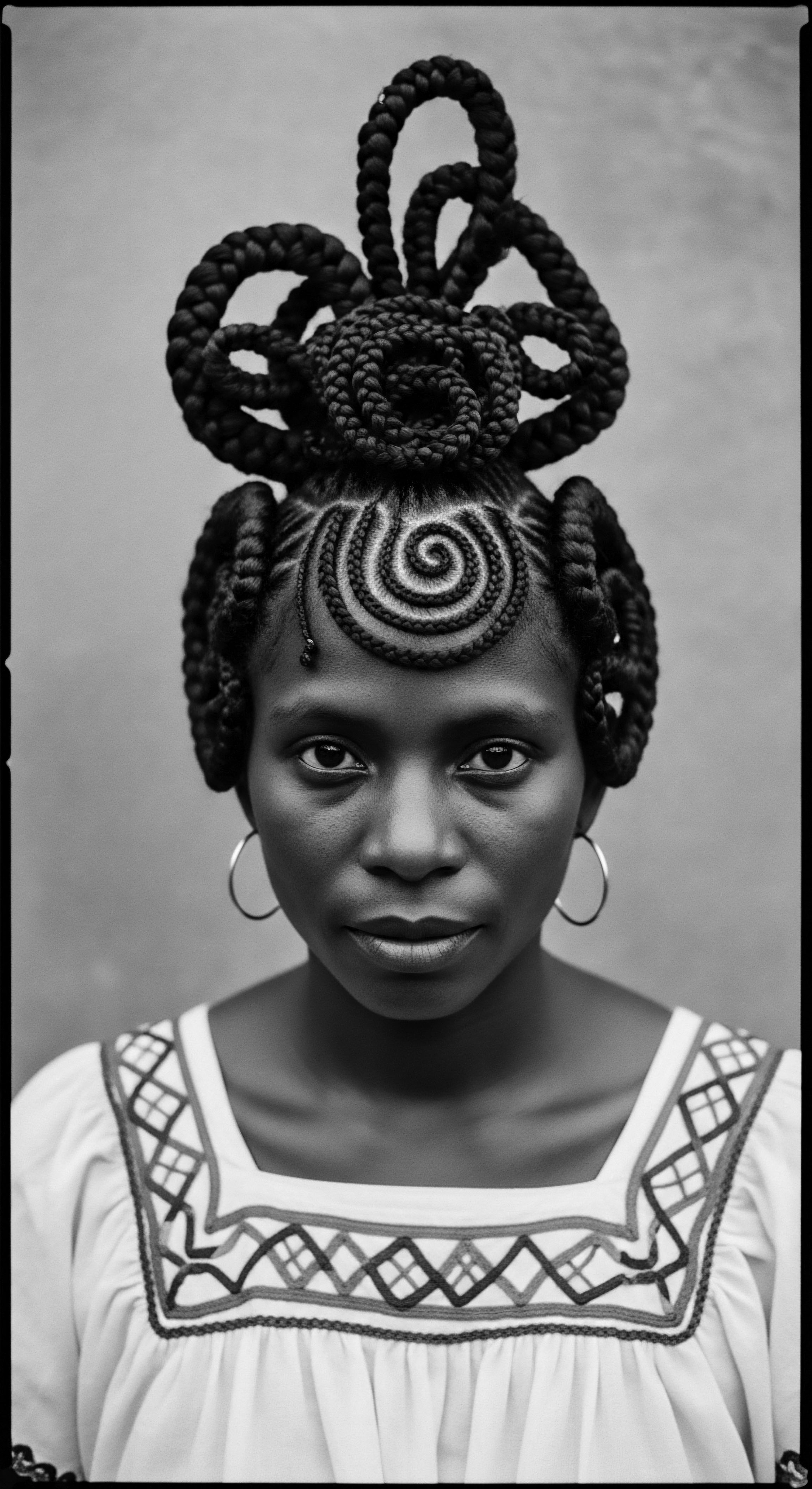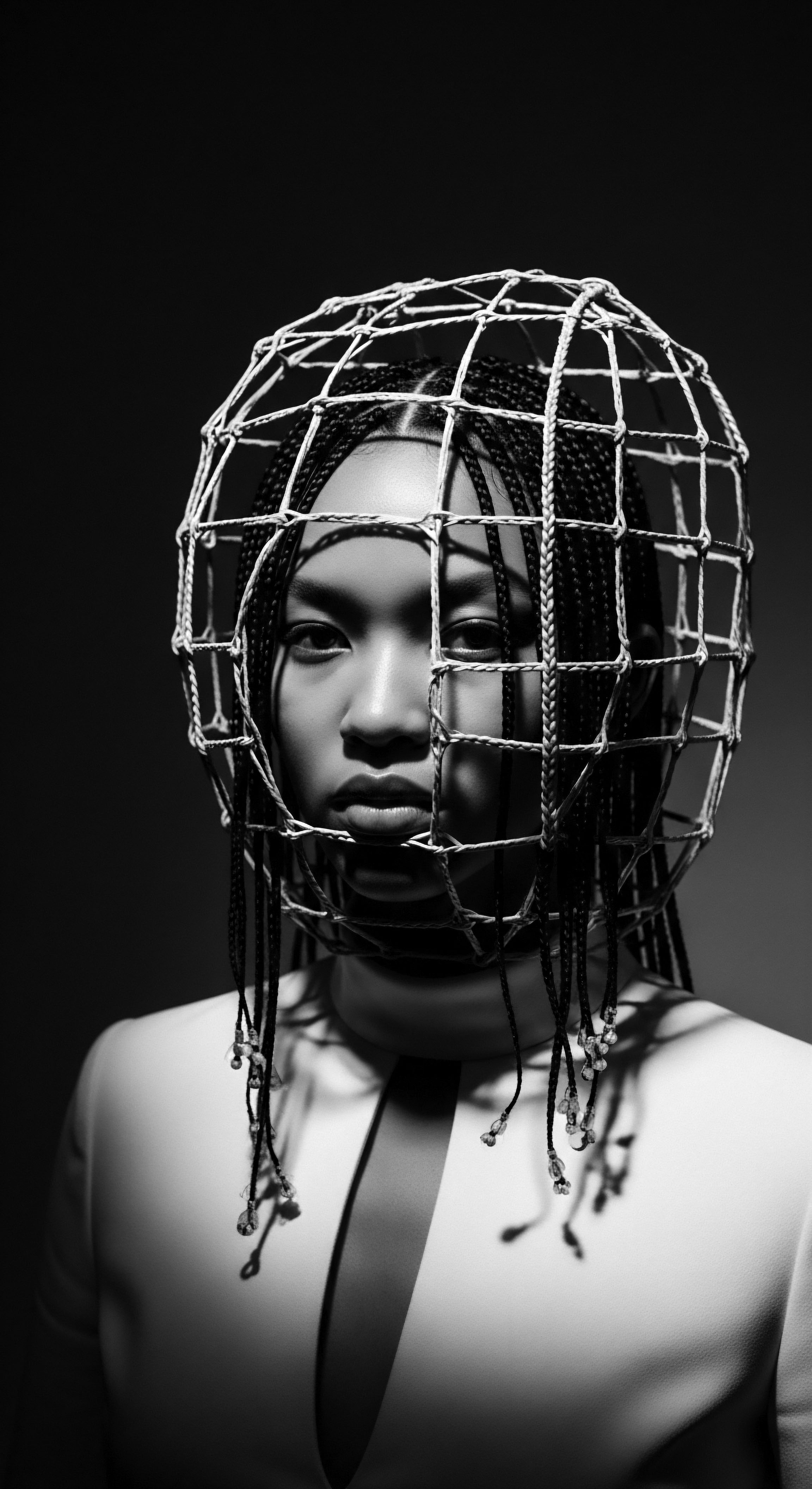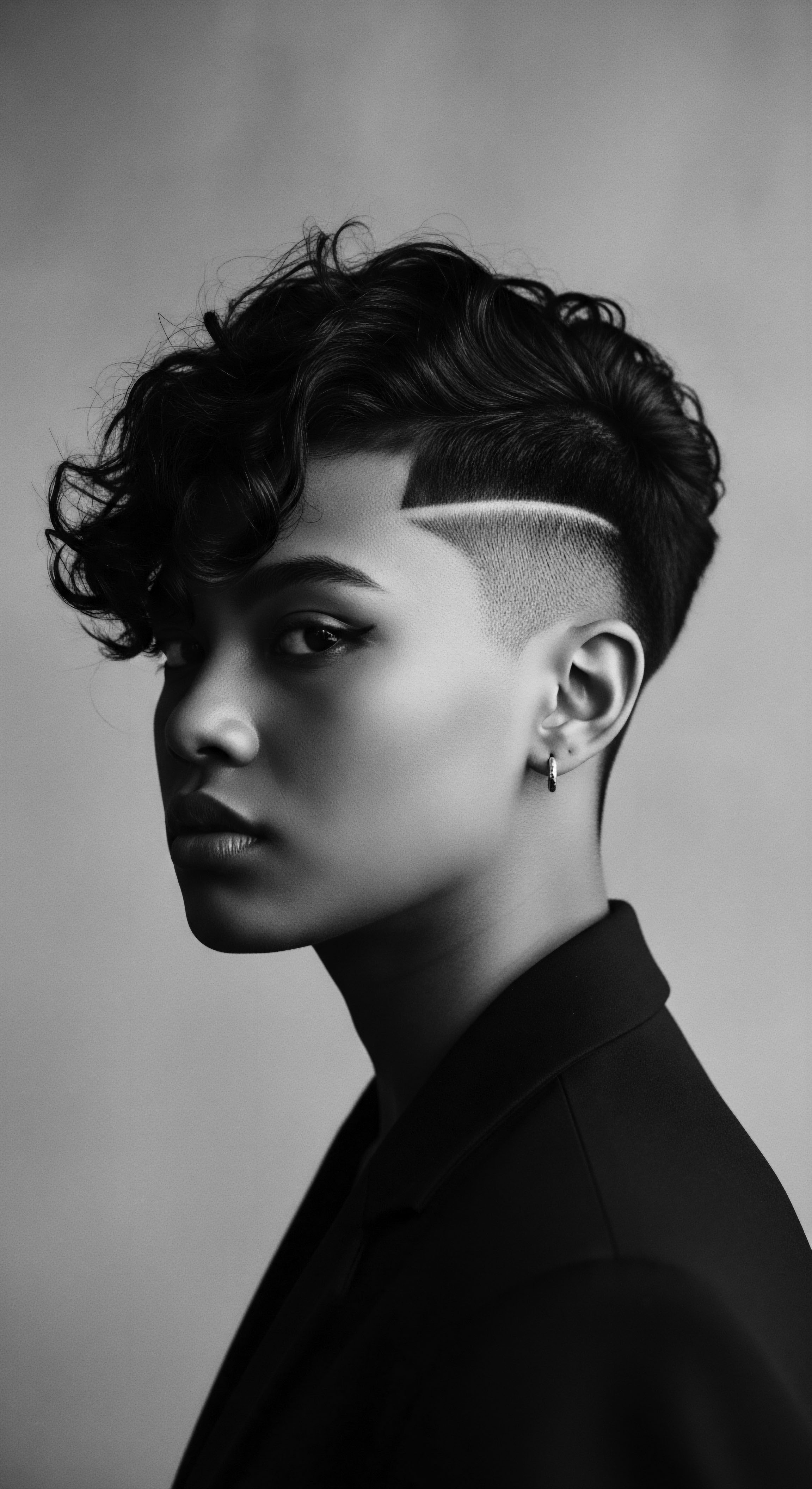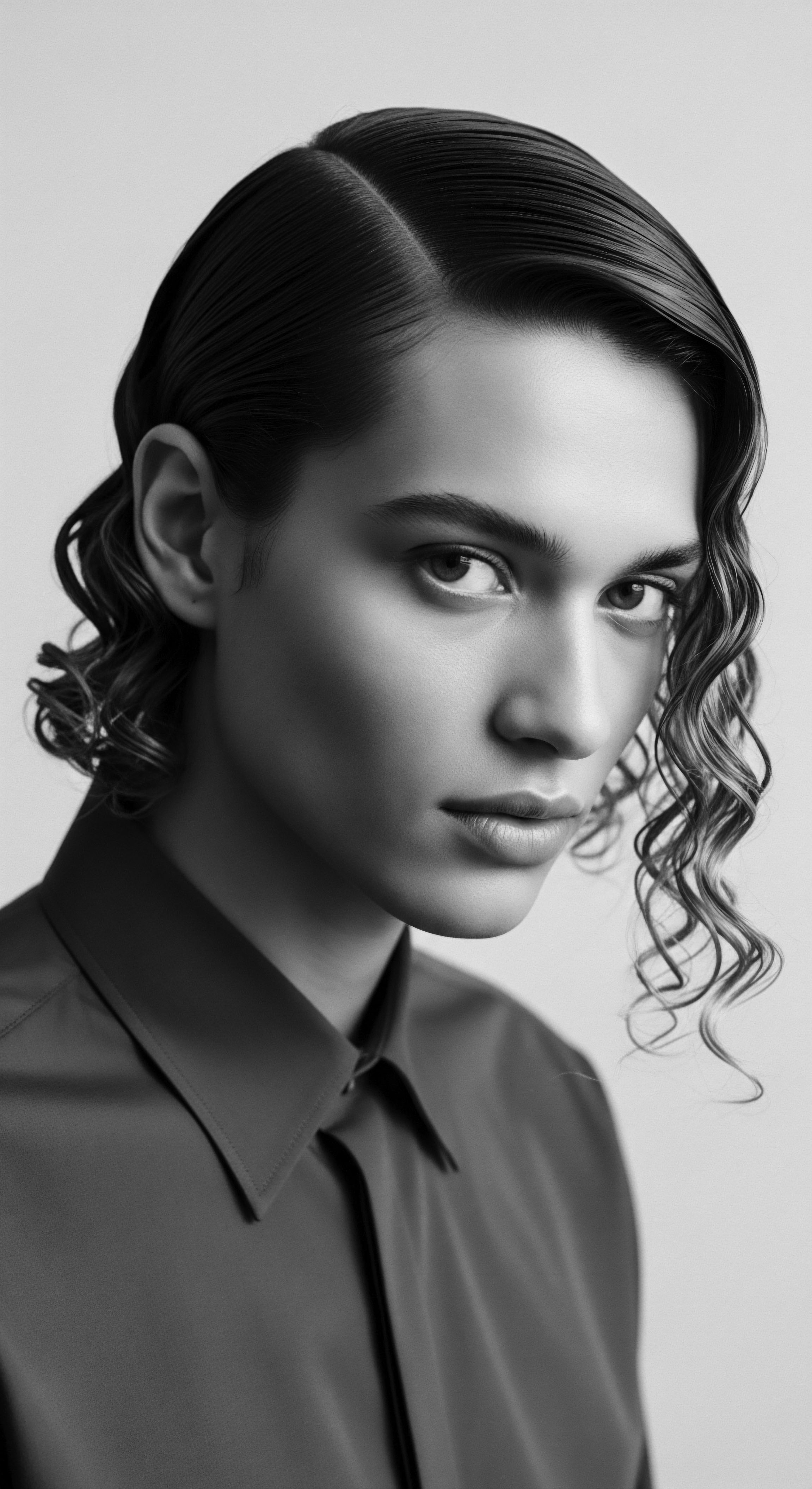
Fundamentals
The concept of Kongo Art, when viewed through the lens of Roothea’s commitment to Textured Hair Heritage, transcends mere aesthetic appreciation. It offers a profound understanding of how visual expressions intertwine with ancestral practices, spiritual beliefs, and the very fibers of identity for Black and mixed-race communities. At its core, Kongo Art represents a dynamic dialogue between the seen and the unseen, a visual language deeply embedded in the life ways of the Kongo people, whose historical territories span parts of present-day Democratic Republic of Congo, Republic of the Congo, and Angola. These artistic manifestations are not static relics; they are living testaments to a worldview where every form, every material, and indeed, every strand of hair, holds intrinsic meaning and significance.
This artistic tradition, which has influenced African American visual culture and spirituality since the transatlantic slave trade, provides a foundational understanding of how art can serve as a repository of cultural memory and a conduit for spiritual connection. It is an elucidation of how a community expresses its cosmological perspectives, social structures, and healing practices through tangible forms. The very designation of “Kongo Art” thus becomes an interpretation of a vibrant cultural system, a statement of its enduring legacy, and a delineation of its unique contributions to the global tapestry of human expression.
In its simplest form, Kongo Art can be understood as the visual and material culture originating from the Kongo Kingdom and its successor societies. This includes a vast array of objects, from the famed Nkisi Figures, which are spiritual vessels, to textiles, regalia, and everyday items. The art is characterized by its powerful symbolism, often incorporating materials from the natural world to embody spiritual forces and ancestral presence. It is a description of a visual lexicon that communicates complex ideas about protection, justice, healing, and community well-being.
Kongo Art, at its most fundamental, embodies a spiritual language woven into the very fabric of daily life and material culture.
Understanding Kongo Art, particularly for those new to its depths, begins with recognizing its intrinsic connection to the spiritual and social harmony of the Kongo people. It is not merely about decorative objects; it is about the active participation of these forms in maintaining balance within the community. For instance, the renowned Nkisi Nkondi, often recognized by the nails or blades embedded in their wooden forms, were not idols but rather powerful instruments used to address communal concerns such as illness, disputes, or the pursuit of justice.
These figures, empowered by ritual specialists known as Nganga, often contained sacred substances, sometimes including hair or nail clippings, to enhance their spiritual potency. This direct inclusion of human elements speaks volumes about the Kongo understanding of interconnectedness between the individual, the community, and the spiritual realm.

Intermediate
Stepping into a more intermediate comprehension of Kongo Art reveals its profound meaning as a living, breathing archive of ancestral wisdom, particularly as it relates to textured hair heritage. The Kongo worldview, often expressed through its artistic output, perceives the human body, and especially the head and hair, as a significant site of spiritual energy and social communication. This deep sense of connection to hair, seen as a crown of glory and a conduit to the divine, permeates Kongo artistic expressions and informs a broader understanding of Black and mixed-race hair experiences across the diaspora.
The interpretation of Kongo Art is inseparable from the cosmological principles that guide the Kongo people. The circular pattern of hair growth on the crown, known as Nzita, was even seen as spiritually vulnerable, leading to the design of protective headwear like the Mpu, a cap worn by chiefs that mimicked the hair’s whorls. This specification of how natural hair patterns informed sacred objects highlights the deeply integrated relationship between the body, spirit, and artistic creation. It is a clear explication of how hair was not merely an aesthetic choice but a potent symbol of status, spiritual connection, and collective identity.
The significance of hair in Kongo and broader African societies extends beyond individual adornment; it was a visual language conveying a person’s family background, tribal affiliation, social status, and even emotional state. This deep historical context provides a powerful lens through which to understand the enduring legacy of textured hair traditions. Consider the Mangbetu People of Congo, whose cone-shaped hairstyles were not only aesthetically valued but were also part of a practice of head elongation, demonstrating a cultural ideal of beauty and status. Such practices underscore how hair was actively shaped and adorned to reflect societal values and individual identity, a practice that continues to echo in contemporary textured hair styling.
Kongo Art’s visual lexicon consistently reinforces hair’s role as a potent symbol of identity, status, and spiritual connection within ancestral traditions.
The continuity of these practices, even after the forced displacement of millions during the transatlantic slave trade, speaks to the resilience of cultural heritage. The Kongo diaspora, through various creolized forms, reestablished aspects of their cultural heritage in the Americas, including elements of their artistic and spiritual traditions. This included the subtle, yet profound, influence on hair practices. For example, while direct, quantifiable statistics on the percentage of Kongo hair practices retained in the diaspora are difficult to isolate due to the syncretic nature of cultural transmission, anecdotal and historical accounts suggest a persistent emphasis on hair as a marker of identity and resistance.
As Robert F. Thompson’s work on Kongo carryovers in African American folk art indicates, these influences can be traced back to the antebellum period, suggesting a deep, often subconscious, preservation of ancestral aesthetics and beliefs surrounding the body and its adornment.
| Aspect of Hair Hair as Identity Marker |
| Kongo/African Cultural Meaning Signified tribal affiliation, social status, age, marital status, and even wealth. |
| Contemporary Relevance to Textured Hair Heritage Continues to represent cultural pride, self-acceptance, and connection to ancestry for Black and mixed-race individuals. |
| Aspect of Hair Hair as Spiritual Conduit |
| Kongo/African Cultural Meaning Considered a site of spiritual energy, connection to ancestors, and a medium for communication with the divine. |
| Contemporary Relevance to Textured Hair Heritage Many textured hair practices (e.g. locs) are viewed as spiritual journeys, symbolizing growth and connection to heritage. |
| Aspect of Hair Hair as a Communal Ritual |
| Kongo/African Cultural Meaning Hair styling was a social bonding experience, often involving family and community, passing down knowledge. |
| Contemporary Relevance to Textured Hair Heritage Braiding sessions and communal hair care continue to be spaces for storytelling, connection, and cultural transmission. |
| Aspect of Hair Hair as a Protective Element |
| Kongo/African Cultural Meaning Specific hairstyles and headwear (like the mpu) were used to cover spiritually vulnerable areas. |
| Contemporary Relevance to Textured Hair Heritage Protective styling remains a core aspect of textured hair care, safeguarding strands while honoring traditional aesthetics. |
| Aspect of Hair The enduring cultural and spiritual meanings of hair in Kongo and broader African traditions provide a foundational understanding for the significance of textured hair today. |

Academic
From an academic perspective, the meaning of Kongo Art represents a sophisticated interplay of cosmology, social structure, and material culture, deeply informing the nuanced understanding of textured hair heritage within Black and mixed-race experiences. It is a designation that moves beyond mere categorization of artifacts to a comprehensive explication of a dynamic cultural system, one where artistic production serves as a primary vehicle for transmitting ancestral knowledge and maintaining communal equilibrium. The rigorous examination of Kongo artistic practices, particularly those involving human elements like hair, offers a profound insight into the ontological frameworks of Central African societies and their enduring resonance across the diaspora.

Cosmological Underpinnings and the Embodied Spirit
The core of Kongo Art’s meaning lies in its profound connection to the Kongo cosmos, a universe conceptualized as a continuous cycle between the living and the ancestral realms, often visualized through the Dikenga, a cruciform symbol. Within this framework, objects, especially the powerful Minkisi (singular ❉ Nkisi), are not simply representations but active agents, imbued with spiritual force. The selection and incorporation of specific materials into these figures, including human hair, nails, and other organic substances, are not arbitrary; they are meticulously chosen for their symbolic and energetic properties.
This practice reflects a sophisticated understanding of sympathetic magic and the belief that fragments of a person or powerful natural elements could anchor or activate spiritual potency within the object. As Volavkova (1972) notes, the Nkisi figure is an assemblage of heterogeneous materials, all contributing to its complex identity as a work of art and a spiritual tool.
The inclusion of hair in Nkisi figures, often concealed within cavities in the head or abdomen, or attached to the exterior, speaks to a deeply rooted ancestral belief in hair as a repository of personal essence and spiritual energy. This is not merely a symbolic gesture; it is a practical application of cosmological principles. The hair, as the outermost extension of the body and closest to the heavens, was considered a vital point of connection to the spiritual world and the seat of one’s life force. This perspective offers a compelling counter-narrative to Eurocentric views that often devalued or misunderstood textured hair, highlighting its intrinsic sacredness within African epistemologies.

Hair as a Socio-Spiritual Archive ❉ A Case Study in Mangbetu Aesthetics
To illuminate the Kongo Art’s connection to textured hair heritage, consider the historical example of the Mangbetu People, an ethnic group closely related to the broader Kongo cultural sphere, inhabiting parts of the Democratic Republic of Congo. Their distinctive Lipombo, or head elongation practice, and the elaborate cone-shaped hairstyles (like the Edamburu) that adorned these elongated heads, serve as a powerful case study. This was not a mere fashion trend; it was a profound expression of beauty, intelligence, and social status.
The practice began in infancy, with the gentle binding of infants’ heads to encourage an elongated cranial shape, a physical manifestation of cultural ideals. The intricate styling of hair around these elongated forms, often involving braiding and threading techniques, was a communal affair, passed down through generations, strengthening social bonds and transmitting cultural knowledge.
This practice, though declining in the mid-20th century due to colonial influences, demonstrates how hair was an active medium for sculpting identity and conveying complex social messages. The time and communal effort invested in these hairstyles were not simply for aesthetic appeal but for the creation of a living, breathing sculptural form that communicated lineage, status, and collective values. The precise delineation of these hairstyles, often requiring hours of meticulous work, underscores the high regard for hair as an artistic canvas and a sacred extension of self. This historical example offers a unique insight into how textured hair, in its myriad forms, has always been a profound statement of cultural identity and ancestral connection, defying simplistic or derogatory interpretations.
The cultural continuity of these practices, even amidst the immense disruptions of colonialism and the transatlantic slave trade, is a testament to the resilience of African cultural forms. The forced shaving of heads upon enslavement was a deliberate act of dehumanization, an attempt to strip enslaved Africans of their identity and spiritual connection, severing their visual ties to their heritage. Yet, the very act of recreating and adapting hair practices in the diaspora, often in secret or in modified forms, became an act of profound resistance and a means of preserving a vital aspect of their ancestral legacy. The persistent emphasis on braiding, coiling, and intricate styling in Black hair traditions globally can be understood as an echo of these deep-seated Kongo and broader African aesthetic and spiritual principles.
- Nkisi Figures ❉ These power objects, often anthropomorphic, served as spiritual vessels. Their creation involved a dialogue between sculptors and Nganga (ritual specialists) who empowered them with sacred substances, including human hair, to address communal needs.
- Mpu Hats ❉ Worn by Kongo chiefs, these intricately woven caps mimicked the natural whorls of hair, symbolizing spiritual protection and leadership, demonstrating a direct artistic response to hair’s natural patterns.
- Mangbetu Head Elongation and Hairstyles ❉ A striking example of how hair and cranial modification were integrated into a holistic aesthetic and social system, signifying beauty, intellect, and status within the community.
The analysis of Kongo Art also involves understanding its journey from elemental biology to its role in voicing identity. The raw materials used in Kongo artistic creations, from wood to various organic substances, speak to a deep ethnobotanical knowledge. For instance, studies on traditional medicine in the Democratic Republic of Congo reveal a rich understanding of plant properties, with roots, bark, and leaves being the most frequently used parts in traditional remedies.
While specific Kongo ethnobotanical texts detailing hair care ingredients are less commonly cited in readily available academic sources, the broader African context indicates a widespread use of natural ingredients for hair treatment and care. This connection underscores the idea that traditional hair care practices were not merely cosmetic but were rooted in a holistic understanding of well-being, drawing from the earth’s bounty.
The ongoing academic discourse surrounding Kongo Art often examines its post-colonial interpretation and its continued influence on contemporary art and identity movements. The exhibition “The Four Moments of the Sun ❉ Kongo Art in Two Worlds” by Robert F. Thompson and Joseph Cornet marked a significant turning point in recognizing Kongo influences in African American art, highlighting its enduring legacy. This suggests a continuous thread of artistic and cultural transmission, where the profound meaning and spiritual resonance of Kongo Art continue to inform expressions of Black and mixed-race identity in the modern world.

Reflection on the Heritage of Kongo Art
The journey through Kongo Art, seen through the lens of Roothea’s reverence for Textured Hair Heritage, unveils a profound narrative that extends far beyond the confines of museum walls. It is a living, breathing testament to the enduring spirit of a people, a testament woven into the very strands of Black and mixed-race hair across generations and continents. The echoes from the source, the ancient wisdom embedded in the land and its people, resonate deeply within the understanding of hair as a sacred extension of self, a conduit for ancestral memory, and a powerful statement of identity.
The tender thread of care, passed down through communal rituals of braiding, oiling, and adorning, mirrors the meticulous craftsmanship found in Kongo sculptures. Each careful part, every intricate twist, every thoughtful application of natural ingredients speaks to a holistic approach to well-being that honors both the physical and the spiritual. This legacy of care, rooted in a profound respect for the hair’s inherent vitality and its symbolic power, forms an unbroken chain from the ancestral hearths of the Kongo to the diverse textured hair routines practiced today.
As we gaze upon the unbound helix, the spiraling journey of textured hair through history, we recognize the undeniable influence of Kongo aesthetic and spiritual principles. The resilience embedded in each curl and coil, the strength in every tightly woven braid, and the vibrant expressions of self through diverse styles are all reflections of a heritage that refused to be extinguished. Kongo Art, with its profound meaning and enduring significance, offers a guiding light, reminding us that our hair is not merely a biological feature; it is a profound meditation on identity, a living library of ancestral stories, and a powerful declaration of who we are and who we are destined to become. It stands as a testament to the enduring beauty and wisdom of a heritage that continues to shape and inspire, offering not just understanding, but a deep, soulful connection to the past, present, and future of textured hair.

References
- Thompson, R. F. (1981). The Four Moments of the Sun ❉ Kongo Art in Two Worlds. National Gallery of Art.
- MacGaffey, W. (1991). Art and Healing of the Bakongo Commented by Themselves ❉ Minkisi from the Laman Collection. Indiana University Press.
- Sieber, R. & Herreman, F. (2000). Hair in African Art and Culture. Museum for African Art.
- Jacobson-Widding, A. (1979). Red-White-Black as a Mode of Thought ❉ A Study of Triadic Classification by Colours in the Ritual Symbolism and Cognitive Thought of the Peoples of the Lower Congo. Almqvist & Wiksell.
- Volavkova, Z. (1972). Nkisi Figures of the Lower Congo. African Arts, 5(2), 52-59.
- Martinez-Ruiz, B. (2013). Kongo Graphic Writing and Other Narratives of the Sign. Temple University Press.
- LaGamma, A. (2015). Kongo ❉ Power and Majesty. The Metropolitan Museum of Art.
- Byrd, A. & Tharps, L. D. (2001). Hair Story ❉ Untangling the Roots of Black Hair in America. St. Martin’s Press.
- Mbilishaka, A. M. et al. (2020). Black Women’s Hair and Self-Esteem ❉ A Systematic Review. Journal of Black Psychology, 46(2), 125-149.
- Okeke-Agulu, C. (2015). African Art in the Diaspora ❉ An Introduction. University of California Press.
